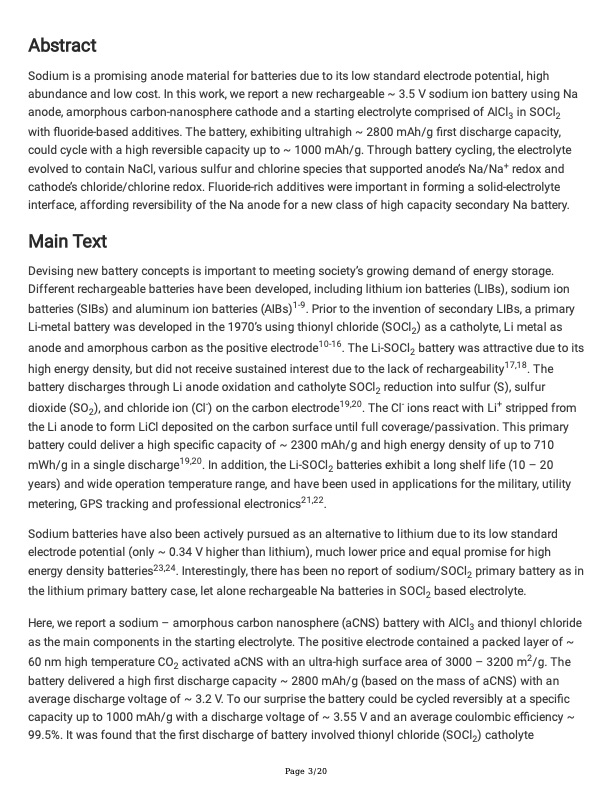
PDF Publication Title:
Text from PDF Page: 003
Abstract Sodium is a promising anode material for batteries due to its low standard electrode potential, high abundance and low cost. In this work, we report a new rechargeable ~ 3.5 V sodium ion battery using Na anode, amorphous carbon-nanosphere cathode and a starting electrolyte comprised of AlCl3 in SOCl2 with �uoride-based additives. The battery, exhibiting ultrahigh ~ 2800 mAh/g �rst discharge capacity, could cycle with a high reversible capacity up to ~ 1000 mAh/g. Through battery cycling, the electrolyte evolved to contain NaCl, various sulfur and chlorine species that supported anode’s Na/Na+ redox and cathode’s chloride/chlorine redox. Fluoride-rich additives were important in forming a solid-electrolyte interface, affording reversibility of the Na anode for a new class of high capacity secondary Na battery. Main Text Devising new battery concepts is important to meeting society’s growing demand of energy storage. Different rechargeable batteries have been developed, including lithium ion batteries (LIBs), sodium ion batteries (SIBs) and aluminum ion batteries (AIBs)1-9. Prior to the invention of secondary LIBs, a primary Li-metal battery was developed in the 1970’s using thionyl chloride (SOCl2) as a catholyte, Li metal as anode and amorphous carbon as the positive electrode10-16. The Li-SOCl2 battery was attractive due to its high energy density, but did not receive sustained interest due to the lack of rechargeability17,18. The battery discharges through Li anode oxidation and catholyte SOCl2 reduction into sulfur (S), sulfur dioxide (SO2), and chloride ion (Cl-) on the carbon electrode19,20. The Cl- ions react with Li+ stripped from the Li anode to form LiCl deposited on the carbon surface until full coverage/passivation. This primary battery could deliver a high speci�c capacity of ~ 2300 mAh/g and high energy density of up to 710 mWh/g in a single discharge19,20. In addition, the Li-SOCl2 batteries exhibit a long shelf life (10 – 20 years) and wide operation temperature range, and have been used in applications for the military, utility metering, GPS tracking and professional electronics21,22. Sodium batteries have also been actively pursued as an alternative to lithium due to its low standard electrode potential (only ~ 0.34 V higher than lithium), much lower price and equal promise for high energy density batteries23,24. Interestingly, there has been no report of sodium/SOCl2 primary battery as in the lithium primary battery case, let alone rechargeable Na batteries in SOCl2 based electrolyte. Here, we report a sodium – amorphous carbon nanosphere (aCNS) battery with AlCl3 and thionyl chloride as the main components in the starting electrolyte. The positive electrode contained a packed layer of ~ 60 nm high temperature CO2 activated aCNS with an ultra-high surface area of 3000 – 3200 m2/g. The battery delivered a high �rst discharge capacity ~ 2800 mAh/g (based on the mass of aCNS) with an average discharge voltage of ~ 3.2 V. To our surprise the battery could be cycled reversibly at a speci�c capacity up to 1000 mAh/g with a discharge voltage of ~ 3.55 V and an average coulombic e�ciency ~ 99.5%. It was found that the �rst discharge of battery involved thionyl chloride (SOCl2) catholyte Page 3/20PDF Image | Rechargeable NaCl Battery Hongjie

PDF Search Title:
Rechargeable NaCl Battery HongjieOriginal File Name Searched:
A_Rechargeable_NaCl_Battery.pdfDIY PDF Search: Google It | Yahoo | Bing
Product and Development Focus for Salgenx
Redox Flow Battery Technology: With the advent of the new USA tax credits for producing and selling batteries ($35/kW) we are focussing on a simple flow battery using shipping containers as the modular electrolyte storage units with tax credits up to $140,000 per system. Our main focus is on the salt battery. This battery can be used for both thermal and electrical storage applications. We call it the Cogeneration Battery or Cogen Battery. One project is converting salt (brine) based water conditioners to simultaneously produce power. In addition, there are many opportunities to extract Lithium from brine (salt lakes, groundwater, and producer water).Salt water or brine are huge sources for lithium. Most of the worlds lithium is acquired from a brine source. It's even in seawater in a low concentration. Brine is also a byproduct of huge powerplants, which can now use that as an electrolyte and a huge flow battery (which allows storage at the source).We welcome any business and equipment inquiries, as well as licensing our flow battery manufacturing.| CONTACT TEL: 608-238-6001 Email: greg@salgenx.com | RSS | AMP |